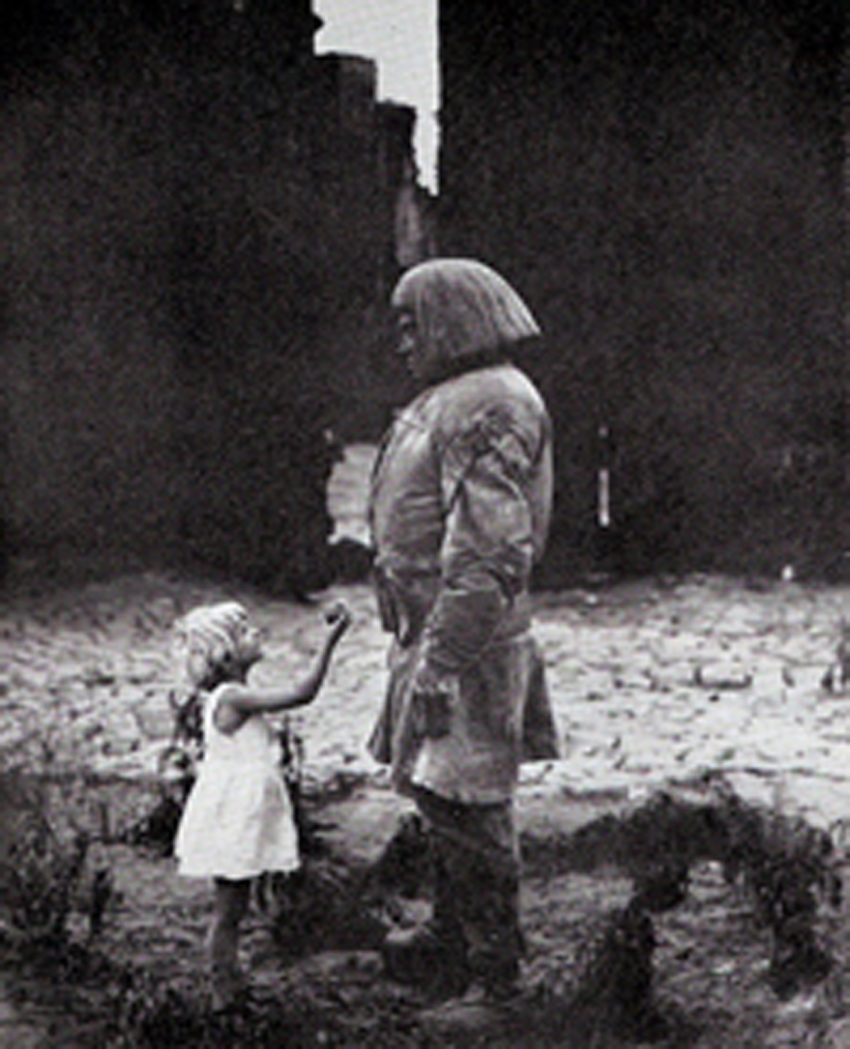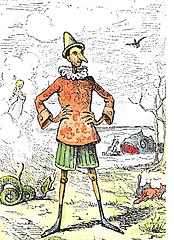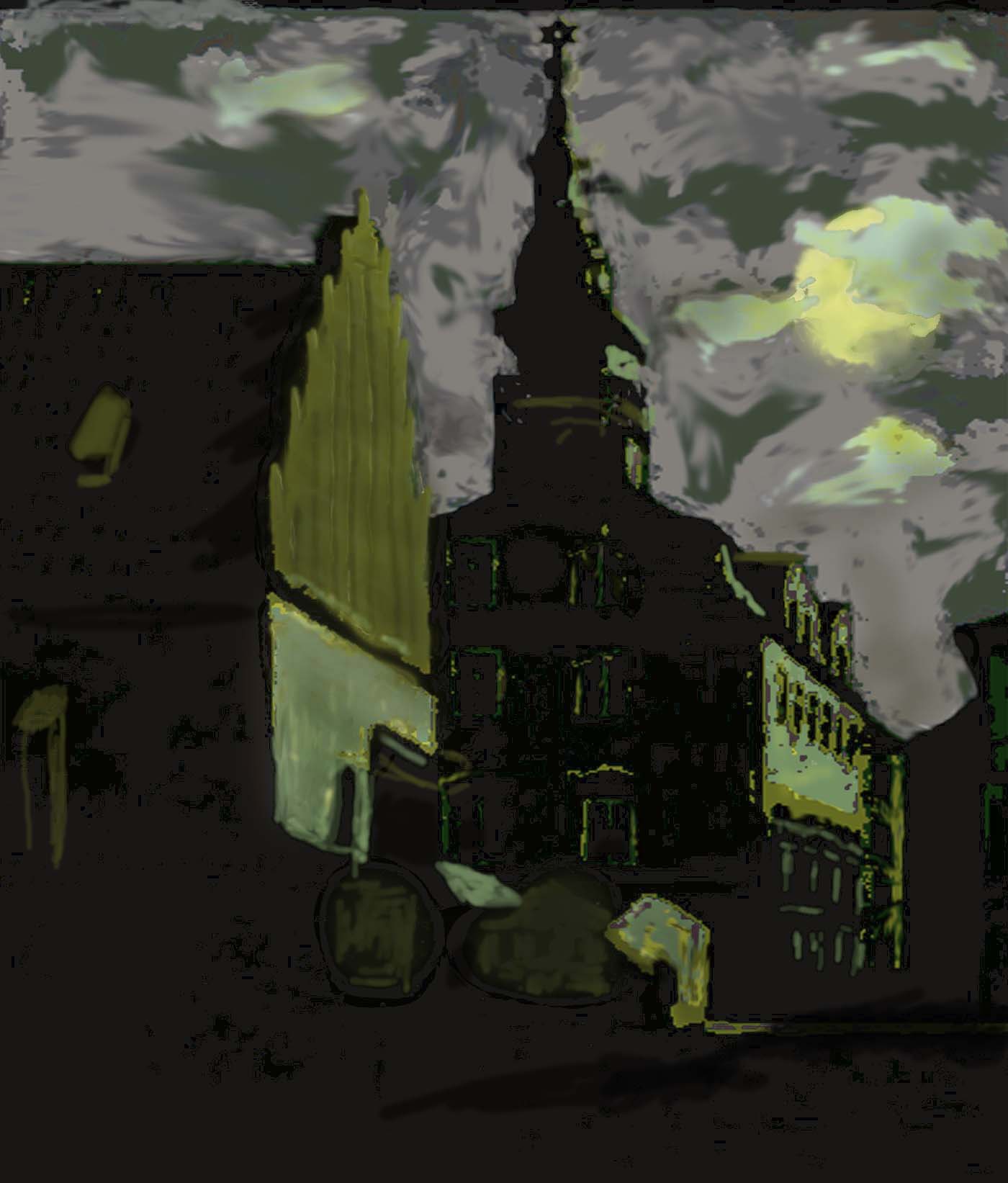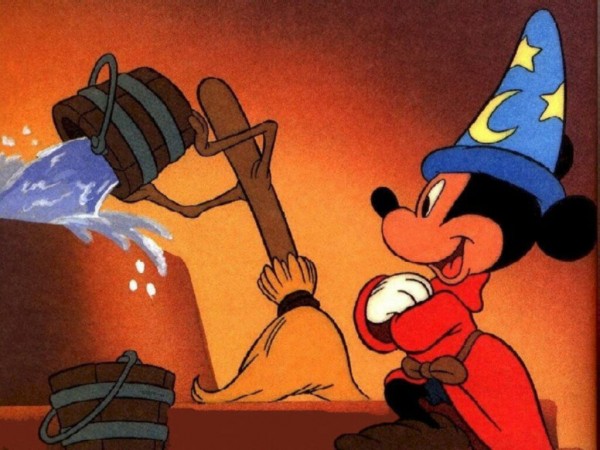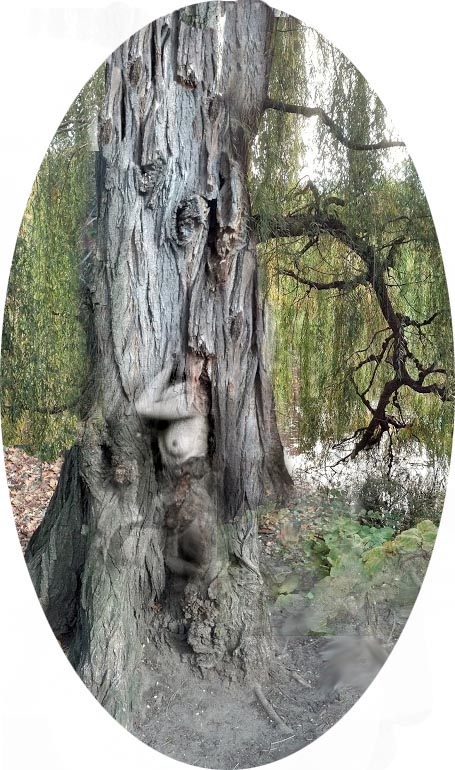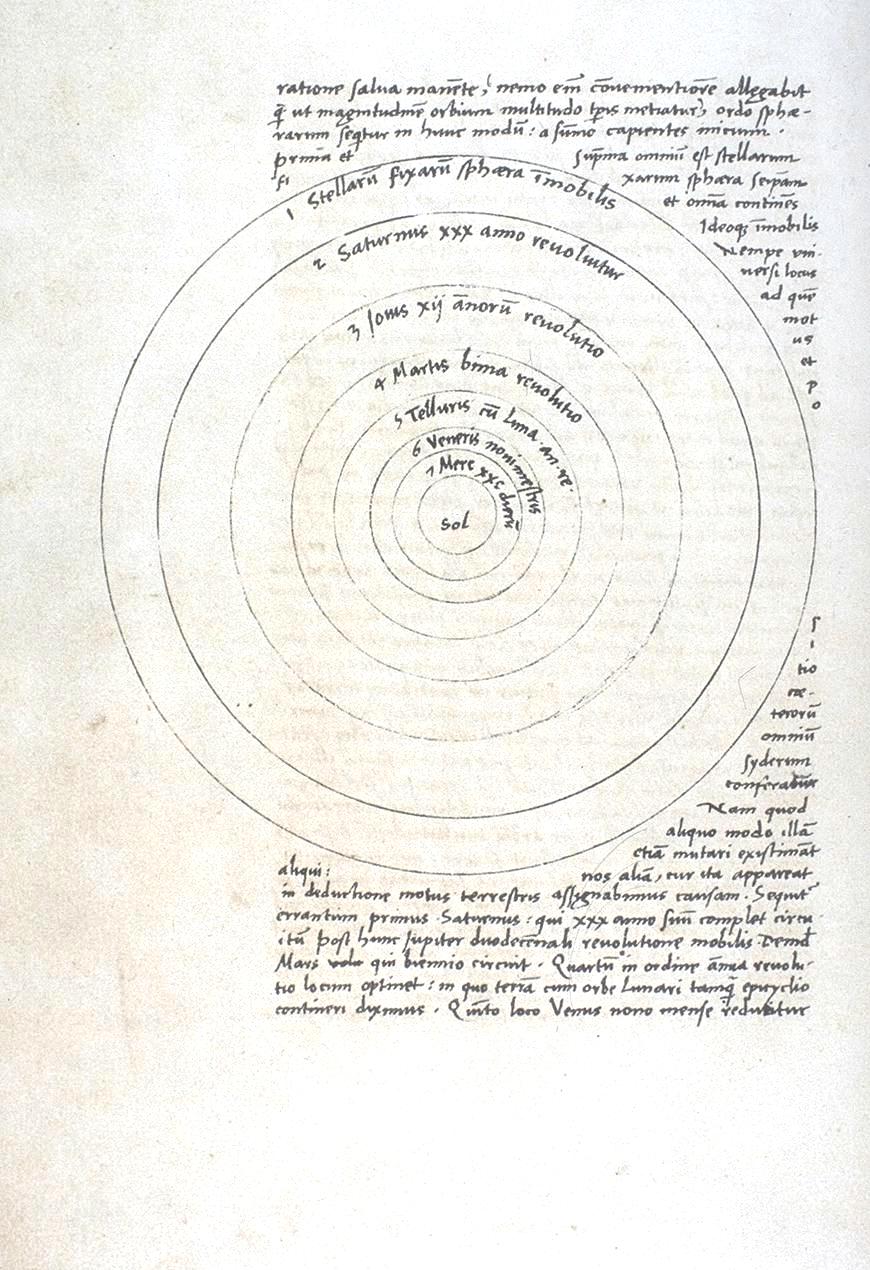Goilem, Annotated is the back story of the famous Prague golem legend: a devout 16th century boy questions his faith as he tries to teach a robot-like creature how to be human.
Structurally, Goilem, Annotated is a frame novel, a boy's adventure digressing into retold and original folktales and historical accounts. In genre, it is a Menippean satire, an oblique attack on modern social convention. At heart, Goilem, Annotated is serious literature.
The market space for Goilem, Annotated is the fantasy-world, the science-fiction sector and readers into religion, the occult, mysticism, astrology, alchemy and magic.
There is also the Gift Economy
(Hyde, 1983) of those wanting to acquaint a late adolescent or young adult with Jewish lore and to ponder social and ethical issues. Physically, Goilem is an art book
: some three-hundred U.S. letter-size pages festooned with color images, a book to be taken seriously, not just leafed-through, though the text reads quickly and is humorously sardonic.
Popular interest has burgeoned for historical tales of mystery that depict common life yet discuss profound philosophical ideas, while touching on the Kabbalah, demonology, alchemy, astrology, shape-shifting, torture, black magic, witchcraft, the Inquisition, conspiracies and religious intrigue. Goilem, Annotated embeds truths, folklore and wisdom in its back story of the golem legend to deliver insight, entertainment and knowledge, going beyond such immensely successful books as The Da Vinci Code and the Harry Potter series by imparting actual facts and presenting both fine and frivolous graphics.
Fascination with the Golem (the title's goilem is how the Yiddish is pronounced) has helped make Prague's Jewish Museum a popular tourist attraction: Michele Obama even left a kvitl petition in the tombstone of Rabbi Löw, the Kabbalah mystic credited as the Prague golem's creator. Among the orthodox there is currently a resurgence of interest in the rabbi's teachings.
Unlike its many predecessors our treatment of the golem story is a skeptical, multilayered and realistic novel set in turbulent, multilingual and multiconfessional Counter-Reformation Prague, a society with remarkable parallels to our own with its questioning of absolutes, its dissolution of the cultural identities (faith, family, community, sovereignty) that provide a sense of meaning in life beyond power and money, its contradictions of growing divisiveness, globalization and centralization, and its pluralistic interests clashing with humanism, religious fanaticism and vicious reactionary forces during an age characterized as unsurpassed for cruelty until our own day
(Wernham, R. B. in Wernham, 1968, Introduction).
Fundamentally, Goilem, Annotated is intended not only to amuse, but to inform and to raise questions. Although profusely illustrated, jocular, tricky and decorated with enough mystery, description of the occult and humor to capture and hold the interest of a wide readership, the novel is constructed around a credible plot, populated with diverse characters and set in a real historical environment that readers can physically tour, a setting that still resounds with the golem legend in its red-roofed medieval and renaissance buildings, its Charles Bridge, its huge castle above the river and its crowded, dynamic Jewish Quarter with its chaotic cemetery and famous Altneu Synagogue as well as the numerous outlets vending golem statues, trinkets and books.
Our gentle reader
is treated as intelligent and inquisitive, and is not regarded as captive to mass media, nor as a simpleton whose attention requires prodding by the crude horror, the awe and the simplistic gloating over the triumph of good versus evil that is the stuff of nearly every existing golem retelling. Instead, the book engages the intellectually and morally curious reader in a struggle with ambiguity, ambivalence and complex emotion. Rather than view its topics with a presumption that progress
, increased tolerance and expanded personal freedom are inevitable, it describes the lived experience, the mundane social and political realities that people faced in rudolfine Prague much as we do now, and how they were affected by the notions and discoveries that have upset the foundations of belief.
Recent politically correct golem versions unquestioningly assume that it is fundamentally wrong to recreate Creation
, that Jews are inevitably little more than innocent hapless victims requiring rescue from unexplainable recurrent anti-Semitism, and that humans are automatically better
than mere machines. Their stock golems are magical, nearly invincible but lumpish, literalist and soulless entities that run amok and therefore must be deactivated. In contrast, our current novel cleaves to objectivity, presents multiple attitudes about issues, and does not patronize the reader into piously taking sides
. It revels in and illuminates mystery, but is not at heart mystical. It describes fascinating notions of magic without glorifying or promoting them. Goilem, Annotated is no Peter Pan fairytale that clumsily and blatantly demands belief in the impossible. It does not resort to the facile story-as-a-dream resolution of The Wizard of Oz. Instead it presents a thoughtful and credible narrative interwoven with descriptions of nascent science, superstition, religion and the occult.
Although Isaac Bashevis Singer's acclaimed child oriented golem rendition (1996) provides at least some rationale for its core conflict—the economically motivated persecution of a Jewish banker—its short story format cramps out detail, confines its fantasy within a distancing, fairytale aura and has neither space for nor interest in psychological nuance or character development.
The Caldicott Award-winning Golem of David Wisniewski (1996) is little more than a beautifully illustrated comic book for children. Its creature may be intelligent, able to speak, and capable of wonder, but, again, brevity precludes adequate exposition. Collodi's wacky Le aventure di Pinocchio (1946) and Mary Shelley's thin, overblown Frankenstein (1995), each founded on the golem model, (Mellor, 1989), have inspired countless further derivatives with their roots in meaningful archetype and their unrealized hints of rich potential, but of course both lack the specific complex flavors of the early modern period, the Jewish experience and the Prague setting.
Of more sophisticated writings, George Bernard Shaw's Pygmalion
is far better written, but it sets out a Greek myth in contemporary dress. Cast of Shadows (Guilfoile, 2005) is a futuristic sci-fi derivative. Although these works, along with Steven Spielberg's Artificial Intelligence
(2001), have enjoyed commercial success, neither avails itself of the material extant in the resplendent capital of the Holy Roman Empire. Even Cynthia Ozik's deliciously ironic explicit golem episode (1998), while referring extensively to Jewish roots, involves molding a golem from potting soil in contemporary Manhattan; and the more recent The Golems of Gotham (Rosenbaum, 2003) is a Manhattan tale as well.
In contrast is Leo Perutz' Nachts unter der steinernen Brücke (2009), released in English translation as By Night under the Stone Bridge, which does concern Jewish–Catholic relations in rudolfine Prague; but its stories are magical and are not specifically golem tales.
Elaborating far more authentically on the original
middle European legend are the superb golem chapters punctuating Marge Piercy's He, She, and It (1991), which brilliantly portray a magical Counter Reformation Prague adventure as counterpoint to the futuristic society that is the main concern of the novel. Marek Halter's Le kabbaliste de Prague (2010) attempts to describe the Prague ghetto accurately, but the golem is a work of magic. Similarly, Francis Sherwood's somewhat silly The Book of Splendor (2002) may come close to a golem treatment that explores the political and religious conditions extant in turn of the century Prague, but having a seamstress fall in love with a supernatural golem hardly does justice to the skepticism and scientific enlightenment that was already so much a part of the setting. Lisa Goldstein's limpid young adult-oriented The Alchemist's Door (2002) similarly partakes of the exciting advances, cultural struggles and aura of mysticism of the city but fully presupposes the veracity of the occult and the effectiveness of the practices of the English adept John Dee, who has inadvertently caused his daughter to be possessed by a demon.
Itself no golem story, Joshua and Ann-Lee Gilder's Heavenly Intrigue (2004) is a straightforward investigative report that attempts to document the alleged murder of the Emperor's famous Royal Mathematician Thyge Brahe by the disgruntled, flamboyant and boastful astronomer Johannes Kepler. The production of that book exemplifies the serious attention non-scholar writers and publishers have been giving (only since 1973) to rudolfine Prague as a pivotal cultural and political center.
Recently the popular fascination with frank golem stories has burgeoned.
Mickey Mouse's portrayal of von Goethe's Sorcerer's Apprentice
(Algar &
Armstrong, 1940) aside,
it is since their revival in the 1950s that proliferation
of golem-inspired super-hero adventures has been accelerating.
With the Hulk
comic books, TV series and movie franchise,
the golem figure harks back to its original model with particular candor.
The popularity of books containing actual golems continues to increase
(see
this).
The Golem and the Jinni was a 2013 New York Times Bestseller,
and there's a Golem opera in the works.
Publishers' grasp of market potential enabled a plethora of overt Golem-of-Prague books for children to emerge in the 1990s along with some scholarly work and literary criticism about various treatments of the legend (including two suppressed works by Franz Kafka). However, none of this recent production fills the niche awaiting the instant Goilem, Annotated.
Our unique approach is particularly relevant during the current clash of civilizations
turmoil and the emerging influence of the Internet, the latter analogous to the new technologies associated with the Renaissance for reproducing written, drawn, and sculpted creations. Even for late adolescents barraged by crude, commercialized and dumbed-down golem spawn, our Goilem combines an intriguing view of mysticism with a sensible, reasoned and informative perspective on the onset of the XVIIth century in Europe, accomplished through a fictive back story
of how the legend could have come about. Philosophically it portrays some of the incompatibilities between Catholicism, Protestantism, revived Classical world views and Judaism as perceived at the turn of that century; and it contrasts the bounded, perfect anthropocentric music of the spheres
model of the world involving unbroken correspondences on every level of existence, against the emerging picture of an infinite cosmos with an immense scattering of suns all obeying mechanistic laws in complete disregard of humanity. Goilem, Annotated depicts the struggle in both the gentile and the Jewish Prague cultures as the old agricultural, monarchical and ecclesiastic value system gave way to more urban, communal and secular
humanism of the Renaissance and the technological advances of the dawning modern age (Witt, 2003, page 199). Psychologically, Goilem, Annotated concerns the task of reconciling the received traditions of one's elders with direct personal observation, how the fancies of childhood and the thoughts of old age meet and are laid to rest, in the experience of the individual
(Pater, 2005, page 22.).
Goilem, Annotated is set in the countryside, streets, taverns, rich and poor homes, palaces and ghetto of Counter Reformation Prague. Economically, politically and religiously motivated anti-Semitism strongly influenced official policy towards Jews in Bohemia and distorted personal encounters with them, but, like slavery, anti-Semitism was controversial among the educated inhabitants of the culturally heterogeneous, advanced and cosmopolitan capital of the Holy Roman Empire. Jewish converts to Christianity could almost fully blend into the population and receive titles of nobility at a time before fears of racial
taint had developed. Openly observant Jews could become prominent in science and philosophy. In overcrowded rudolfine Prague, Jews and Christians even shared rented rooms outside the ghetto and squabbled in the local courts of law.
Our story of the Golem emerges through the point of view of a fictional 12-year-old orphan, Natan, the putative grandson of the famed actual historical Chief Rabbi of Prague known as the MaHaRaL. The rabbi has apparently instantiated a golem to protect the ghetto, a walled-in slum at the outskirts of the bustling and turbulent capital of the Holy Roman Empire. The rabbi entrusts Natan to train the creature to pass for human so that it could rally the Jewish community to resist the next pogrom being fomented within the local Bohemian population. The naiveté and impersonal objectivity of the golem and the concreteness of Dan, Natan's young sidekick
, wrench Natan from the constricting perspectives of his peers and teachers and he critically examines the issues he encounters to the considerable extent possible in a thoughtful pre-teen. Natan grows to love the Golem and struggles to understand why the rabbi ultimately seeks to do away with the creature. In discovering the rabbi's reasons and the truth about the Golem Natan learns about human motives, social forces, personal wisdom, responsibility, hubristic creativity and the dangers and responsibilities of power. He also must struggle with his need to connect with other people and form relationships in the face of his new alienating perspective and quest for individuality, and his need to find meaning and dignity outside of the existing religious, political and economic structures.
Of course Natan cannot fully resolve his issues and the novel provides no pat answers or viewpoint. Instead it aims to raise universal questions about religious, racial and ethnic prejudice, the nature of truth, the foundations of social conflict and the workings of politics in terms that resonate with a contemporary audience. Its plot leads to a dramatic, but not moralistic, conclusion and heads off into a potential sequel novel, a picaresque adventure across Europe.
Historical detail enriches the book's setting. Bohemian and Jewish religious and cultural practices are neither cartooned as quaint, endearing, despicable or outmoded impediments to scientific advancement nor denigrated as inferior to modern ideals of personal identity or romantic love, but rather are dignified as being philosophical positions and lifestyles on a par with many current XXIst century ones. The fascination Americans have developed for medieval life—as manifested by the proliferation in so many media of Dungeons and Dragons
derivatives—will readily extend to the late XVIth century environment as well, when our currently more-satisfying humanism was displacing scholasticism and theology, as well as agricultural, monarchical and ecclesiastical values. The current longstanding and widespread New Age involvement with astrology and alchemy, together with the commercial success of such pseudo-historical pop thrillers as The Da Vinci Code (Brown, 2003) and Angels and Demons (Brown, 2000) promise an eager readership for Goilem, Annotated and the possibility of developing historically accurate cinematic versions based on its plot and that of a sequel.
Prominent Characters
Yehudah Löw ben B'ẓal'el ben Ḥayim
(Dates: Poznań, ca. 1525–Prague, 1609), Chief Rabbi of Prague known as The MaHaRaL
and as The Lion of Judah
(historical person).
Though revered by observant Jews and intensely studied to this day as a great thinker and interpreter of Jewish law and Agadic tradition, Rabbi Löw is most often popularized as the holy mystic who made the Golem. Prominent but controversial in his time, he both epitomized and transcended the struggle of all educated modern Jews to deal with continual threats to one's philosophy, livelihood and life. Historically, some powerful community leaders wanted to oust Rabbi Löw from his post; the Holy Roman Emperor considered having the Rabbi killed; and threats to the Jewish community of Prague were constant, real and dire.
Rudolf II Habsburg
(Vienna, 1552–Prague, 1612), the intermittently psychotic Holy Roman Emperor, who made Prague his permanent capital (historical person).
Rudolf embodied the contradictions of his age. His immense power was vitiated by his bouts of depression, phobias, persecutory delusions and demonic pursuit of the finest in thought, art, knowledge and technology and was undercut by enemies with various personal, religious and political motives.
Natan ben Zalman ben Yehudah
The rabbi's 12-year-old orphaned putative grandson (fictional).
Goilem, Annotated plays out through the point of view of this initially ordinary early adolescent whose illusions are shredded by experience.
Yosef ben Nun
Reputedly a golem created by the MaHaRaL (fictional).
Dan
Natan's cousin, also age 12 (fictional).
Dan's marked intellectual limitation, concreteness and credulousness serve as springboard for Natan's growing understanding of reality.
Others
The MaHaRaL's wife, a girl, Natan's classmates, a Bohemian derelict
References
- ^ Algar, J., & Armstrong, S. (Writers). (1940).
Fantasia.
USA: Walt Disney Productions. - ^ Brown, D. (2000). Angels and Demons. New York: Atria (Simon & Schuster).
- ^ Brown, D. (2003). The Da Vinci Code. New York: Doubleday.
- ^ Collodi, C. (1946/1883). Le avventure di Pinocchio [Pinocchio's Adventures]. New York: Grosset & Dunlap, Publishers.
- ^ Dekel, E., & Gurley, D. G. (2013). How the golem came to Prague. Jewish Quarterly Review103,2,241-58
- ^ Dekel, E., & Gurley, D. G. (2017). Kafka's golem. Jewish Quarterly Review107,4,531-56
- ^ Gilder, J., & Gilder, A.-L. (2004). Heavenly Intrigue: Johannes Kepler, Tycho Brahe, and the Murder Behind One of History's Greatest Scientific Discoveries (1st ed.). New York: Doubleday.
- ^ Goldstein, L. (2002). The Alchemist's Door (1st ed.). New York: Tor.
- ^ Guilfoile, K. (2005). Cast of Shadows. Knopf.
- ^ Halter, M. (2010). Le kabbaliste de Prague. Paris: Éditions Robert Laffont. ISBN: 2-221-11353-5.
- ^ Hyde, L. (1983). The Gift: Imagination and the Erotic Life of Property. Vintage Books
- ^ Mellor, A. K. (1989). Mary Shelley: Her Life, Her Fiction, Her Monsters. Routledge.
- ^ Ozik, C. (1998). The Puttermesser Papers: A Novel. New York: Vintage Books.
- ^ Pater, W. (2005). The Renaissance: Studies in Art and Poetry. (Paperback ed.) Dover Publications.
- ^ Perutz, L. (2009). By Night Under the Stone Bridge. The Harvill Press.
- ^ Piercy, M. (1991). He, She, and It. New York: Knopf (originally published as Body of Glass in the UK).
- ^ Rosenbaum, T. (2003). The Golems of Gotham. Perennial.
- ^ Shelley, M. (1995/1818). Frankenstein; or, The Modern Prometheus. New York: Washington Square.
- ^ Sherwood, F. (2002). The Book of Splendor (1st ed.). New York: W. W. Norton & Company.
- ^ Singer, I. B. (1996). The Golem (I. B. Singer, Trans. Paperback ed.) New York: Sunburst (Farrar Straus Giroux).
- ^ Spielberg, S. (2001).
Artificial Intelligence: AI.
Warner Brothers. - ^ Wecker, H. (2013). The Golem and the Jinni. New York: Harper Perennial.
- ^ Wernham, R. B. (Ed.). (1968). The New Cambridge Modern History, Vol. 3: Counter-Reformation and Price Revolution, 1559-1610 (Vol. III). New York: Cambridge University Press.
- ^ Wisniewski, D. (1996). Golem. New York: Clarion Books.
- ^ Witt, R. G. (2003). In the Footsteps of the Ancients: The Origins of Humanism from Lovato to Bruni (Paperback ed.) Brill Academic Publishers.




